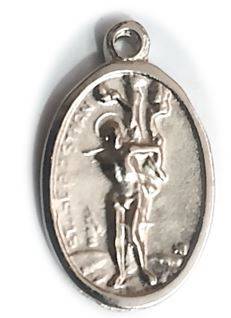
St Sebastian Medal
Check my rate
| Main centres: | 1-3 business days |
| Regional areas: | 3-4 business days |
| Remote areas: | 3-5 business days |

| Main centres: | 1-3 business days |
| Regional areas: | 3-4 business days |
| Remote areas: | 3-5 business days |

St Sebastian Medal
2.5cm long x 1.5cm wide

Facts
Feastday:
January 20
Patron:
of soldiers, athletes, and those who desire a saintly death
Death: 288
Nothing is known about St. Sebastian's youth other than the fact he
may have come from southern France and he was educated in Milan. He
joined the Roman Army in 283 AD, ostensibly to be of service to other
Christians who were being persecuted by the Romans. St. Sebastian
distinguished himself and for his excellent service, he was promoted to
serve in the Praetorian Guard to protect Emperor Diocletian.
While serving as a Praetorian Guard, Marcus and Marcellian, twin
brothers, were imprisoned for refusing to make public sacrifices to the
Roman gods. The brothers were deacons of the Christian Church. During
their imprisonment, their parents visited them to implore them to
renounce Christianity. However, St. Sebastian convinced both parents to
convert to Christianity. St. Sebastian also converted several other
prominent individuals, including the local prefect.
This led to his discovery and he was reported as a Christian to
Emperor Diocletian in 286. The Emperor, who was already infamous for
ordering the deaths of hundreds of Christians, scolded Sebastian and
ordered him to be killed by having him tied to a stake on a training
field and used as target practice.
Archers riddled his body with arrows, his body was described as,
"full of arrows as an urchin." Believed to be dead, the archers left
his body for retrieval and burial. He was recovered by Irene of Rome,
whose Christian husband was a servant to Diocletian and also martyred.
Irene discovered that Sebastian was still living and she hid him and
nursed him back to health.
Once well, Sebastian went in search of Diocletian to surprise him. He
managed to catch Diocletian by a stairwell and proceeded to criticize
him loudly and publically for his persecution of the Christians.
Diocletian, surprised that Sebastian was still alive, was immediately
taken aback, but recovered his composure. This time, he would not permit
Sebastian to escape with his life. He ordered his former guard to be
beaten to death with clubs, then thrown into the sewers.
His body was recovered by a Christian woman, named Lucina, and she secretly buried him in the catacombs beneath Rome.
Nearly 80 years after his death, around 367, his remains were moved
to a basilica in Rome, built by Pope Damasus I. His body, or at least
some relics from his body were reportedly removed and shared with a
community of monks in France. His cranium was sent to a German monastery
where it was placed in a special silver case in 934. The relic remains
in its case today in a special reliquary in Ebersberg.
St. Sebastian was commonly invoked as a protector against the plague.
According to historical records, he defended the city of Rome against
the plague in 680. His association with the plague could be because he
survived being shot full of arrows and in pagan belief, pestilence was
delivered by arrows shot by the gods above. Even Christian Romans would
appreciate this symbolism. That symbolism is even captured in artwork as
late as the Renaissance, where artists painted plague victims with
black arrows in their body.
In artwork, St. Sebastian is depicted with arrows shot into his body,
often tied to a post or a tree. His second execution is virtually never
depicted.
St. Sebastian is the patron saint of soldiers, athletes, and those who desire a saintly death.